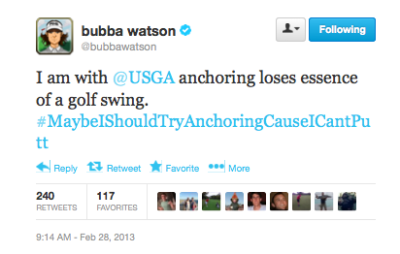My colleague Sam Weinman is probably right that there are probably bigger issues in the game to be quibbling over than the proposed anchoring ban. I might have agreed, until the entire episode took on a new, bizarre and disconcerting twist when Commissioner Tim Finchem made his case last weekend by severely stretching the truth. And as Frank Hannigan pointed out in his letter to this site, Finchem had a long time to prepare his case.
The wise readers of this site knew it right away, and now the media is now calling him out. It should be noted, as I pointed out on Morning Drive Monday, that Finchem may just be doing the bidding (for a change) for his players, and averting a lawsuit. But a master debater who has had over a year to prepare a rebuttal failed so badly that his national television appearance could reflect poorly on the PGA Tour.

Jaime Diaz dismantles all of Finchem's key arguments for opposing the anchoring ban in a must-read Golf World column.
The lethal paragraph:
It would have been easier to accept if the commissioner hadn't been so obviously spinning. Like claiming that 20 percent of amateurs anchor, which is patently ridiculous compared to Golf Datatech research that puts the number at less than 5 percent. Or saying that the USGA had allowed anchoring since 1975 when the first long-putter cases occurred in the mid-1980s. Or maintaining that the USGA and R&A have conceded that anchoring provides no competitive advantage, when the associations have taken no stance on that criteria. Or that Webb Simpson and Keegan Bradley "grew up" with the belly putter, when Simpson switched from conventional in college and Bradley a year after turning pro. All things the old debate champion wouldn't have done with a real opponent in front of him.
Robert Lusetich refers to Finchem's "bullying tactics" and highlights how the debate shifted with Finchem not exactly refuting the prevailing view of players that its unfair to have amateurs making the rules of golf:
Instead of arguing the merits of anchoring, proponents have twisted the debate, making it more about the USGA and R&A.
They persuaded PGA Tour players by preying on their historic dislike of golf’s ruling bodies; on the idea that amateurs shouldn’t be deciding what professionals can and cannot do.
They said that the USGA has allowed anchoring for 40 years, that’s there’s no data showing a competitive advantage for anchoring — a dubious assertion given many bad putters anchor, thus dragging down performance data — and that it won’t grow the game, as many golfers with the yips would stop playing.
“The USGA approved it twice,” Finchem noted.
And of course, they did not, something Bob Harig addressed already.
Michael Williams at GolfWRX also takes on the Commissioner and says "golf must be honest and consistent about its reasons" for banning anchoring, and he says the USGA/R&A has held up their end of the bargain. By going on national television the way Finchem did while uttering factually problematic statements, Williams says Finchem failed the game when he tried to pass off the "no competitive advantage" canard.
Finchem said in an interview there there was an “absence of data or any basis to conclude that there is a competitive advantage to be gained by using anchoring.” In one sense, he is correct. Of the top 20 percent of the Tour’s leading putters, none used an anchored putter. But the point is not if the long putter makes a given player statistically better than everyone else; the only meaningful statistic is if it makes the player better than he or she might have been using an unanchored putter with a conventional stroke. While the Tour has no way to compile such statistics, you can bet the players and their putting gurus do. If the putter works by the numbers on the practice green, then you can bet they are going to bring it to the course.
The USGA/R&A never conceded this "no competitive advantage" point. They made clear this is about the potential that an anchored stroke may provide a competitive advantage and may alter the competitive challenge of making a stroke.
The USGA/R&A emphasized that its proposal "comes in response to the recent upsurge in the use of anchored putting strokes at all levels of the game, combined with growing advocacy by players and instructors that anchoring the club may alleviate some of the inherent challenges of traditional putting and therefore may be a preferred way to play the game."
And: "The player’s challenge is to direct and control the movement of the entire club in making the stroke. Anchoring the club removes the player’s need to do so by providing extra support and stability for the stroke, as if one end of the club were physically attached to the body.”
So here's the big problem with the "no competitive advantage" talking point Finchem presented: anchorers say that this method of lodging hand against torso does not provide them an advantage, but the moment it was suggested the governing bodies might take that anchoring option away, they said they would their living would be fundamentally impacted if not for the ability to anchor.
Who needs data when you get admissions like that?
 And then there's Tim Clark's "plight."
And then there's Tim Clark's "plight."
Randall Mell talked to some players at the Honda Classic Tuesday who admitted that Clark's sad saga of genetic condition convinced them to oppose the ban.
Another canard.
“Tim Clark got up and said some things that were very sincere, about his livelihood and his family,” said Brandt Jobe, who was there. “When Tim spoke, that really impacted players who would have been on the fence. A lot of people who didn’t really care that much were affected by the points Tim made that night and decided, ‘I’m going in that direction.’”
Clark has a genetic condition that prevents him from turning his forearms and wrists inward. He has used a long putter for several years.
And under the proposed rule change, Clark will (A) be able to continue to use the same exact putter he uses now, and (B) will be able to grip that putter exactly the same way he has before, with one difference: the putter must not be anchored to his torso.
Clark and those with similar physical ailments merely have to move the putter 1/2 to 1 inch from their bodies.
Same grips. Same putters. Only now they have to use only their hands and arms to stroke the ball.
Naturally, we all know these pros are unhappy about this simple shift because they believe they have gained a competitive advantage in anchoring the putter against their torso. Trying to claim anything otherwise while also suggesting livelihoods will be impacted means the "no competitive advantage" claim is an outright falsehood. And this is why any empathy some of us might have had for professional anchorers will be abandoned. (As for amateur yippers who may give up the game, that's another subject entirely and I don't know the answer.)
Professional golfing anchorers have a little less than four years to move their putter grip just millimeters away from their chest. In light of the mistruths they've spread after a good-faith effort by the governing bodies to hear their feedback, the USGA and R&A must call Tim and Tim's bluff and usher in the proposed Rule 14-1b ban.
 With most of the success coming for long putter users coming in Hawaii, Sobel says:
With most of the success coming for long putter users coming in Hawaii, Sobel says:















